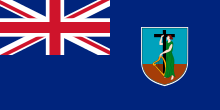MONTSERRAT
 Montserrat is nicknamed “The Emerald Island” because of its green vegetation and its Irish heritage. Its area is 101 sq km. Montserrat owns two islets : Little Redonda and Virgen ; Statue Rock. Montserrat is very mountainous : in the north, Silver Hill (403 m) ; in the centre, Centre Hill with its peak Katy Hill (741 m) ; the Soufrière Hill with its highest point, Chance Peak (915 m).
Montserrat is nicknamed “The Emerald Island” because of its green vegetation and its Irish heritage. Its area is 101 sq km. Montserrat owns two islets : Little Redonda and Virgen ; Statue Rock. Montserrat is very mountainous : in the north, Silver Hill (403 m) ; in the centre, Centre Hill with its peak Katy Hill (741 m) ; the Soufrière Hill with its highest point, Chance Peak (915 m).
In the fauna, 90 species of bird are counted. The national bird is the endangered Montserrat loriot, a yellow and black little bird. The big toad – endemic to Montserrat and Dominica – is cooked for the national dish, the “mountain chicken”. In the wildlife, there are also iguanas, spiders, agoutis etc.
The tropical vegetation is composed of rare plants like the orchid of Montserrat (Epidendrum Montserratense), ferns, taros, tall trees (mangos tree, breadfuit tree…).
The eruption of the Soufrière Hills on July 1995 buried the capital, Plymouth, under 12m of ash. Two years later, the volcano killed 19 inhabitants. Since this natural disaster, Montserrat’s economy has been stopped. Until 1994, Montserrat had about 13 000 inhabitants. Approximately 8000 people left the island to take refuge primarly in the United Kingdom. The government tries to boost tourism. Before, export, business, selling and shipping agregate for building were among the most important economic activities.
On 11th November 1493, during his second voyage to the West Indies, Christopher Columbus discovered the island and named it after “Santa Maria de Montserrat” the steep mountains where is the Montserrat’s monastery, outside Barcelona, in Spain. The Carib Indians who replaced the Arawak Indians in the island called it “Alliouagana” (The Land of Thorny Bushes). In 1632, the first Europeans arrived in Montserrat. The majority of the settlers were Catholic and Irish who fled the persecutions of Protestants in St Kitts and Nevis. During the next years, other Irish workers came to earn their living in the fields. In the 18th century, thousands of African slaves were transported to Montserrat to work in about one hundred of sugar cane plantations.
France owned the island between 1665 and 1712 then, in 1782 partly helped by the Irish colonists who did not have confidence in the English. In 1783, Montserrat became again British by the Treaty of Paris. The sugar price collapse and the Abolition of slavery in 1834 caused the bankruptcy of many plantations. The growing of lemon trees took the place of the growing of sugar cane. In 1885, Montserrat’s lime exports peaked. In 1941, its cotton production boomed.
In 1962, when the British West Indies Federation was dissolved, Montserrat chose to stay a British overseas territory because the island did not want to be “associated” with Antigua or St Kitts and dominated by both islands.
Montserrat has a governor who represents the British monarchy and a locally elected government led by a chief minister.
The new capital, Brades, is in the north-west of Montserrat.
Area : 101 sq km (39 sq miles)
Population : 5 100 inhabitants
Capital : Brades (ex capital : Plymouth)
Language : English
Currency : East Caribbean Dollar (EC$)
People : Montserratians
